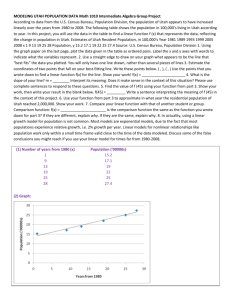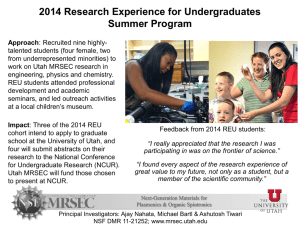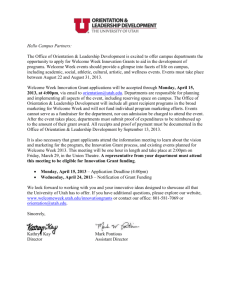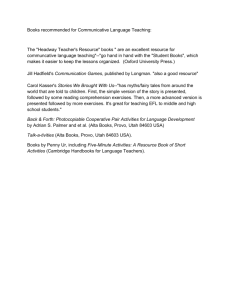File - Collett Litchard, STUDENT
advertisement
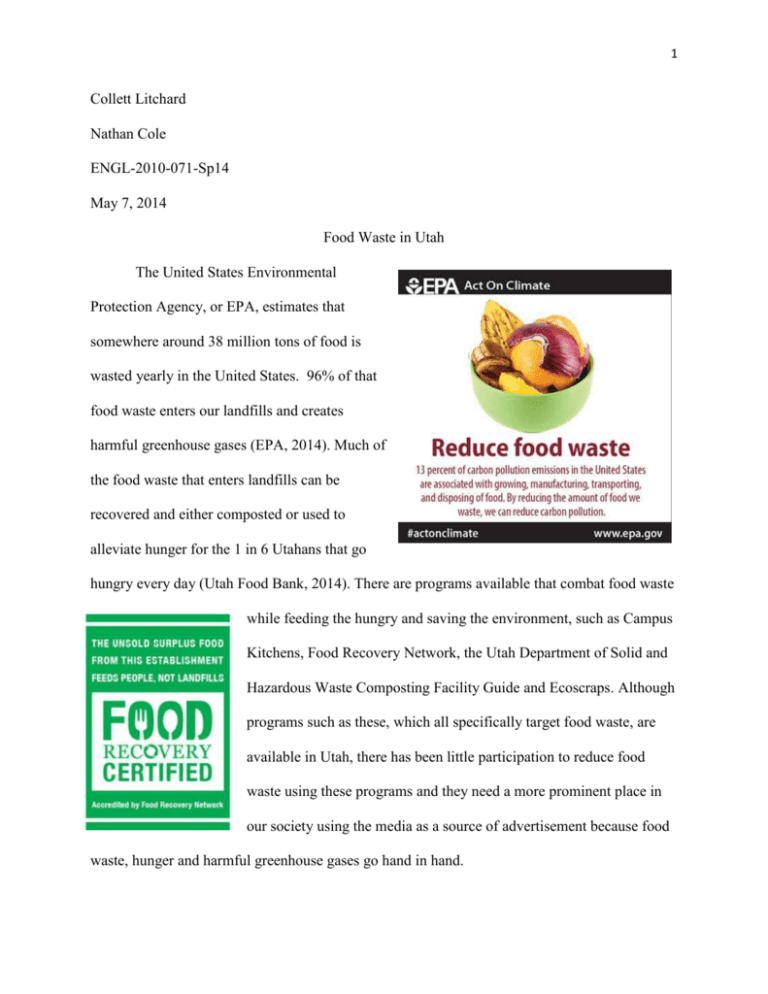
1 Collett Litchard Nathan Cole ENGL-2010-071-Sp14 May 7, 2014 Food Waste in Utah The United States Environmental Protection Agency, or EPA, estimates that somewhere around 38 million tons of food is wasted yearly in the United States. 96% of that food waste enters our landfills and creates harmful greenhouse gases (EPA, 2014). Much of the food waste that enters landfills can be recovered and either composted or used to alleviate hunger for the 1 in 6 Utahans that go hungry every day (Utah Food Bank, 2014). There are programs available that combat food waste while feeding the hungry and saving the environment, such as Campus Kitchens, Food Recovery Network, the Utah Department of Solid and Hazardous Waste Composting Facility Guide and Ecoscraps. Although programs such as these, which all specifically target food waste, are available in Utah, there has been little participation to reduce food waste using these programs and they need a more prominent place in our society using the media as a source of advertisement because food waste, hunger and harmful greenhouse gases go hand in hand. 2 The Campus Kitchens Project and the Food Recovery Network are two programs that are trying to help with food waste recovery at a local level that are not being utilized to their potential here in Utah. Both of these organizations recover otherwise good food on its way to landfills and use it to feed the hungry. The food they collect is given to food banks in their area. The Campus Kitchens Project, which prepares and distributes meals made from recovered foods, has zero participating facilities in Utah (The Campus Kitchens Project, 2014). The Food Recovery Network was started in 2011 by students at the University of Maryland to help reduce food waste at their facility. The only two participating units in Utah are Weber State University in Ogden, Utah, which is northern Utah and Brigham Young University in Provo Utah, with a mid-state location. Both of these Utah universities started their local chapters in 2013. Weber State has recovered over 1,000 pounds of food and BYU has recovered over 3,300 pounds of would-be wasted food (Food Recovery Network, 2014). If these two schools are an example of the positive impact action based programs can have, we as a state-wide community can make an even bigger impact by starting more chapters throughout the state. With so little Utah participation in these two programs, it is imperative that more be done in the state of Utah so that CPK by the Numbers 3 our one in six hungry citizens have better access to life sustaining foods. We can do this by advertising these programs on the local television, radio and media sources. The only efforts seen in Utah at a governmental level that address the reduction of food waste has been in the form of a composting facilities guide on the Utah Division of Solid and Hazardous Waste website in 2012 (UDSHW, 2014). The composting facility guide states in the first sentence that this guide is not a rule. In other words, it is not required that a business create and use a compositing facility, it is merely a suggestion. The website gives the researched numbers and explains the benefits of composting to a business’s operations (UDSHW, 2014). This all sounds really compelling, but aside from occasional recycling stations for paper, plastic and aluminum, when was the last time you saw a food waste recycling station? Even on the Utah Division of Solid and Hazardous Waste website, navigation to find composting facilities around the state is difficult. Most consumers aren’t even aware of the program, let alone the locations of where to take their food waste. Unless it becomes easier and more convenient, even environmentally conscious consumers will despair and likely not participate. Ecoscraps, with only two Utah locations, takes inedible food waste and turns it into organic soils through the composting process, thereby preventing it from entering the landfills and creating harmful methane gases that wreak havoc on the atmosphere. Ecoscraps goes around to Utah retailers collecting the food waste that would be sent to landfills. They then turn around and sell the organic soil they create from the food waste and in local retail establishments. The Ecoscraps Tomato Bundle two participating retailers are Gordon’s Nursery in Huntington, Utah and Sutherland’s Lumber in 4 Price, Utah (Ecoscraps, 2014). The entire rest of the state is void of the benefits of the Ecoscraps program. It would be beneficial to Utah’s environment if Ecoscraps were more widely advertised and available. What Utah lacks in the effort to reduce food waste is consumer awareness. The local media has a great opportunity to promote programs such as the four mentioned above. Commercials can be created to bring awareness to businesses and private citizens alike. Do a Google search on “food waste in Utah” and mostly what comes up is news on the statistics. On KSL.com, a local Utah news station, the latest news on food waste had to do with the summer lunch program, and how shameful it was that a lot of that food gets thrown into the trash because the children can’t eat it in the time allotted (Wimmer, 2014). None of the stories mentioned on their site dealt with promoting the programs that are working towards a solution, therefor Utah needs more exposure and participation in food waste reduction programs from our local media. The evidence showing the lack of consistent and impactful food waste reduction program participation and awareness in Utah is overwhelming. With little support and practically no media coverage, The Campus Kitchens Project, The Food Recovery Network, UDSHW composting facilities guide and companies like Ecoscraps, have little chance of making a difference in the fight against food waste and the effects it has on hunger and the environment. Feeding the hungry and protecting the environment are effects of food waste that must be remedied. Utah citizens are uninformed and inconvenienced when it comes to food waste reduction programs. More must be done in the media to bring attention to the vast problem of food waste so that not only the environment is protected, but our state’s one in six hungry are well fed. 5 Works Cited The Campus Kitchens Project, The Campus Kitchens Project, 2001. Web. 4 April 2014. Ecoscraps, Ecoscraps, 2013. Web. 5 May 2014. EPA, “Reducing Wasted Food Basics”, 16 March 2014. Web. 5 May 2014. Food Recovery Network, Food Recovery Network, 2013. Web. 4 April, 2014. Wimmer, Nadine, “Untouched food goes to waste at school feeding programs”, KSL, KSL, 2014. Web. 4 April, 2014. UDSHW, Utah Division of Solid Waste and Hazardous Waste, Solid Waste Management Program, Composting Facility Guidance, May 2012 revision, Web. 21 February 2014. Utah Food Bank, Utah Food Bank, 2006-2014. “Fighting Hunger Statewide”, Web. 4 April 2014. 6 Image Citations The Campus Kitchens Project, CPK by the Numbers, 2013 Calendar Year. Web. 7 May, 2014. Ecoscraps, Ecoscraps Tomato Bundle, 2014. Web. 7 May, 2014. Food Recovery Network, Food Recovery Certified, 2012. Web. 7 May, 2014. Love Food Hate Waste, Love Food Hate Waste, 23 March 2012. Web. 7 May 2014. Blog Epa.gov, Reduce Food Waste, 17 April 2014. Web. 7 May 2014.


